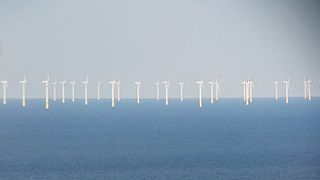
Vattenfall is a Swedish multinational power company owned by the Swedish state. Beyond Sweden, the company generates power in Denmark, Finland, Germany, the Netherlands, and the United Kingdom.

The United Kingdom is the best location for wind power in Europe and one of the best in the world. The combination of long coastline, shallow water and strong winds make offshore wind unusually effective.

Glyncorrwg is a village in the Afan Valley, in southern Wales.
The Thanet Wind Farm is an offshore wind farm 7 miles (11 km) off the coast of Thanet district in Kent, England. On commissioning it was the world's largest offshore wind farm. It has a nameplate capacity of 300 MW and it cost £780–900 million (US$1.2–1.4 billion). Thanet is one of fifteen Round 2 wind projects announced by the Crown Estate in January 2004 but the first to be developed. It was officially opened on 23 September 2010, when it overtook Horns Rev 2 as the biggest offshore wind farm in the world. It has since been overtaken by many others.

Wind power is the fastest-growing renewable energy technology in Scotland, with 11,482 megawatts (MW) of installed wind power capacity by Q1 2023. This included 9,316 MW from onshore wind in Scotland and 2,166 MW of offshore wind generators.

Gwynt y Môr is a 576-megawatt (MW) offshore wind farm located off the coast of north Wales and is the fifth largest operating offshore windfarm in the world. The farm has 160 wind turbines of 150 metres (490 ft) tip height above mean sea level.

The Kentish Flats Offshore Wind Farm is a wind farm located off the coast of Kent, England on a large, flat and shallow plateau just outside the main Thames shipping lanes. The wind farm is operated by Vattenfall.

As of November 2023, wind power in the Netherlands has an installed capacity of 11,602 MW, 40.9% of which is based offshore. In 2022, the wind turbines provided the country with 18.37% of its electricity demand during the year. Windmills have historically played a major part in the Netherlands by providing an alternative to water driven mills.

Blyth Offshore Wind Farm was a small coastal wind farm located 0.5 miles (0.80 km) off the coast of Blyth, Northumberland, England.

The Ormonde Wind Farm is a wind farm west of Barrow-in-Furness in the Irish Sea. The wind farm covers an area of 8.7 square kilometres (3.4 sq mi). It has a total capacity of 150 MW and is expected to produce around 500 GWh of electricity per year.
Vattenfall UK is a subsidiary of Vattenfall headquartered in London. It generates renewable energy, primarily through wind farms.
Vattenfall Nederland B.V. is a utility company based in Amsterdam, Netherlands. It provides electricity, natural gas, and heat. The company belongs to the group of Vattenfall.

Parc Cynog is a wind farm operated by Nuon Renewables in Wales.
Marc Phillips is a Welsh charity manager and former Plaid Cymru politician.
The European Offshore Wind Deployment Centre (EOWDC), also known as the Aberdeen Bay Wind Farm is an offshore wind test and demonstration facility located around 3 kilometres off the east coast of Aberdeenshire, in the North Sea, Scotland. It was developed by the European Offshore Wind Deployment Centre consortium. The scheme is relatively small - it consists of 11 wind turbines with an installed capacity of 93.2 megawatts. It is located between Blackdog and Bridge of Don near Aberdeen. First power was generated in July 2018, with full commissioning following in September 2018.

The East Anglia Array is a proposed series of offshore wind farms located around 30 miles off the east coast of East Anglia, in the North Sea, England. It has begun with the currently operational East Anglia ONE, that has been developed in partnership by ScottishPower Renewables and Vattenfall. Up to six individual projects could be set up in the area with a maximum capacity of up to 7.2 GW. The first project, East Anglia ONE at 714 MW, received planning consent in June 2014 and contracts in April 2016. Offshore construction began in 2018 and the project was commissioned in July 2020. It is expected to cost £2.5 billion.

In 2019, Wales generated 27% of its electricity consumption as renewable electricity, an increase from 19% in 2014. The Welsh Government set a target of 70% by 2030. In 2019, Wales was a net exporter of electricity. It produced 27.9 TWh of electricity while only consuming 14.7 TWh. The natural resource base for renewable energy is high by European standards, with the core sources being wind, wave, and tidal. Wales has a long history of renewable energy: in the 1880s, the first house in Wales with electric lighting powered from its own hydro-electric power station was in Plas Tan y Bwlch, Gwynedd. In 1963, the Ffestiniog Power Station was constructed, providing a large scale generation of hydroelectricity, and in November 1973, the Centre for Alternative Technology was opened in Machynlleth.
The United Kingdom became the world leader of offshore wind power generation in October 2008 when it overtook Denmark.












